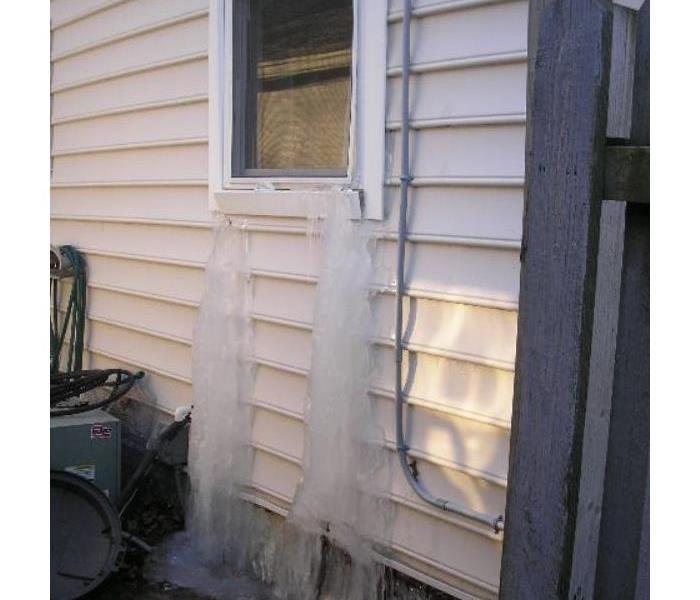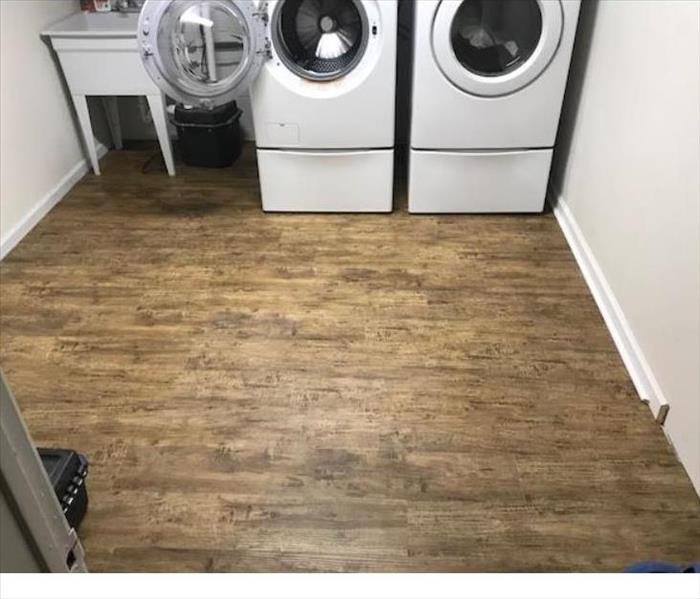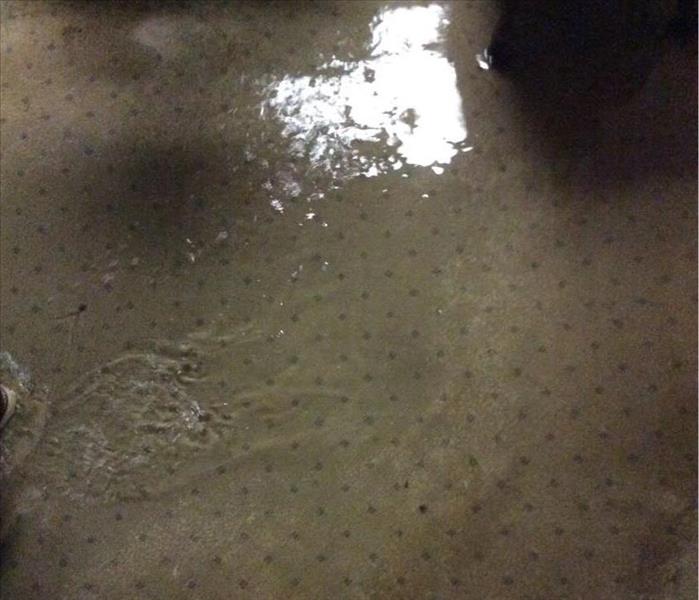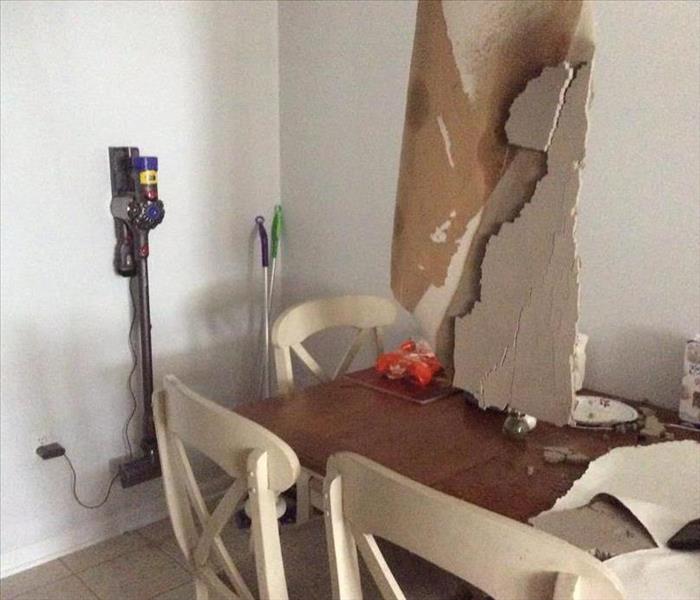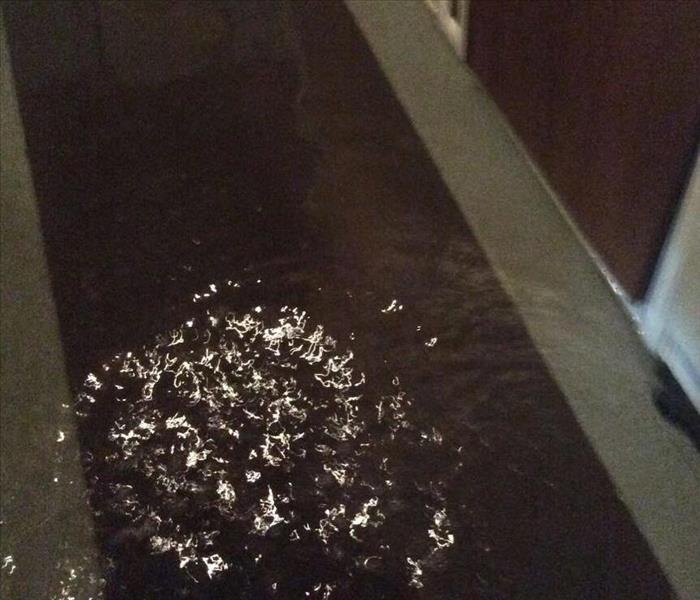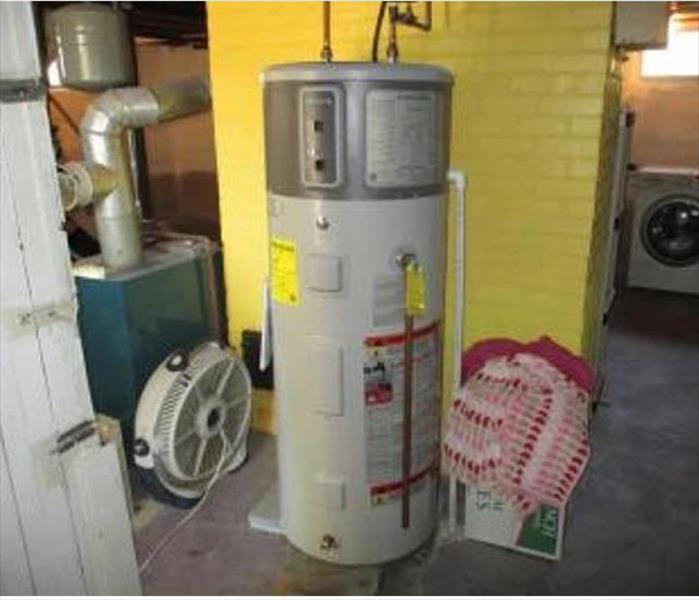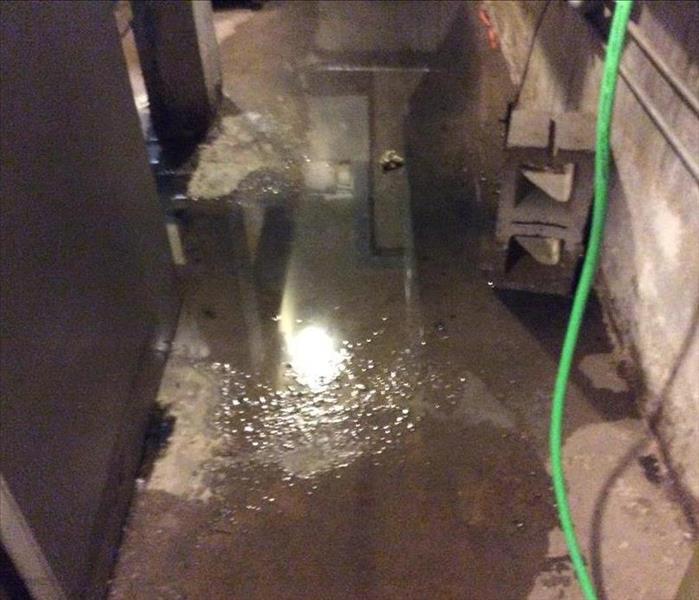Recent Water Damage Posts
Thawing the Freeze: A Guide to Preventing and Dealing with Frozen Pipes
12/14/2023 (Permalink)
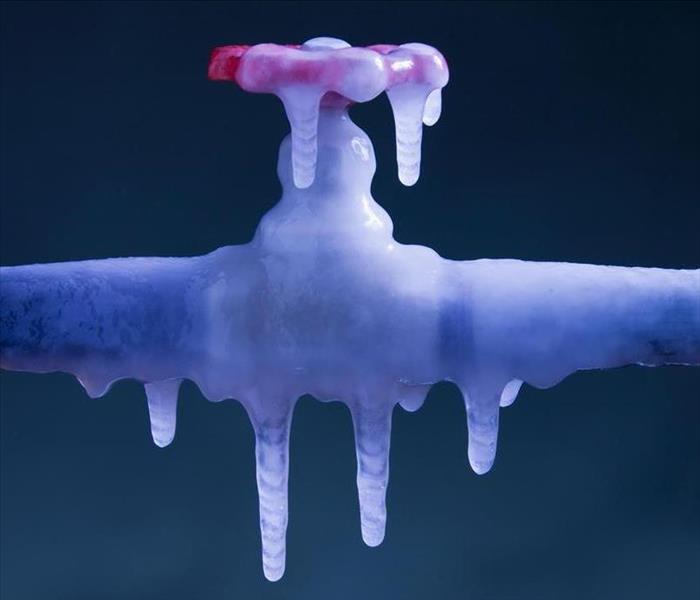 A pipe faucet that has a frozen leak
A pipe faucet that has a frozen leak
Thawing the Freeze: A Guide to Preventing and Dealing with Frozen Pipes
Meet the winter challenge head-on by safeguarding your property against frozen pipes and the potential damage they bring. As temperatures plummet, homes and businesses face the risk of leaks, flooding, and even mold. To ensure your water pipes stay functional and your property remains safe, here's a comprehensive guide:
Frozen Pipes: What You Should Know
Understanding the causes is the first step in prevention. Sudden temperature drops, poor insulation, and low thermostat settings contribute to frozen pipes. The vulnerability increases in pipes running alongside exterior walls, exposed to the elements, and those in unheated spaces.
Tips to Prevent Pipes from Freezing
- Disconnect outside garden hoses and secure outdoor valves.
- Ensure your basement is heated, cover crawl space air vents, and close windows near water pipes.
- Let faucets drip slightly overnight, especially those on outside walls.
- Insulate exposed pipes and use heating tape or pipe insulation.
- Keep cabinets open to let heat reach plumbing, and install weather sealing around windows.
- Regularly check and insulate pipes in unheated areas, like garages.
- Never use antifreeze unless directed, as it can be hazardous.
Can You Thaw Frozen Pipes?
Discovering frozen pipes doesn't have to be a nightmare. Follow these steps:
- Shut off the water supply via the main valve.
- Open a faucet to encourage thawing, and apply heat using an electric heating pad, space heater, or hot towels.
- Never use open flames or kerosene for thawing.
- If in doubt or unable to thaw, call a licensed plumber.
Winter Vacation Tip: Check Your Pipes Before Heading Out
If you're escaping the cold for warmer climes, protect your home:
- Shut off water supply and consider draining the system.
- Keep the thermostat no lower than 55º Fahrenheit (12º Celsius).
- Ask a friend or neighbor to check your house regularly.
SERVPRO’s Water Damage Cleanup Process
Should water damage occur, SERVPRO®
Team Majeski is here to help with our eight-step restoration process:
- Emergency Contact
- Inspection and Water Damage Assessment
- Water Removal
- Damaged Material Removal
- Cleaning, Sanitizing, and Deodorization
- Drying
- Monitoring
- Repairs and Construction
NJ Hurricane Season: Are You Prepared for Water Damage?
9/7/2023 (Permalink)
 waves forming in blue ocean as a result of hurricane
waves forming in blue ocean as a result of hurricane
New Jersey's hurricane season typically spans from June through November, with the highest likelihood of storms occurring between August and October. While the Garden State might not be as hurricane-prone as some other coastal regions, it's essential for residents to be prepared. One of the significant risks associated with hurricanes and tropical storms is water damage to homes and businesses.
Water damage in the home often starts as a small issue that worsens over time. Problems like a leaky pipe, roof damage, or condensation may lead to extensive damage if not detected or addressed promptly. However, during hurricane season, the risks escalate, and the damage can be severe.
Here's what you need to know about preparing for water damage during NJ's hurricane season:
1. Inspect Your Property: Before hurricane season kicks into high gear, take time to inspect your property. Look for any existing issues like leaks, cracks, or damaged roofing that could be exacerbated during a storm.
2. Secure Outdoor Items: High winds can turn outdoor items into projectiles. Secure or store outdoor furniture, grills, and other loose items to prevent damage to your property or neighboring ones.
3. Check Drainage Systems: Ensure that your property's drainage systems, such as gutters and downspouts, are clear of debris and in good working order. Proper drainage can prevent water from pooling near your home's foundation.
4. Create an Emergency Kit: Assemble an emergency kit that includes essential items like bottled water, non-perishable food, flashlights, batteries, a first-aid kit, and important documents. Don't forget to include any necessary medications.
5. Develop an Evacuation Plan: Familiarize yourself with your community's evacuation routes and shelters. Have a plan in place for your family, including pets, in case you need to evacuate.
6. Consider Flood Insurance: Standard homeowners' insurance policies often don't cover flood damage. If you live in an area prone to flooding, consider purchasing flood insurance to protect your home and belongings.
7. Stay Informed: Monitor weather forecasts and stay informed about approaching storms. Sign up for emergency alerts and have a battery-powered weather radio on hand.
8. Trim Trees and Branches: Overhanging branches or weak trees can become hazards during strong winds. Trim trees and branches that could potentially damage your home or power lines.
Despite all precautions, water damage can still occur during a hurricane. If your home experiences water damage, it's crucial to act quickly to minimize further harm. Our team is available 24/7 to respond promptly and mitigate the damage, helping you get your life back to normal as soon as possible.
Don't wait until the next storm hits. Be proactive and prepared to protect your home and loved ones during New Jersey's hurricane season.
Prevent Frozen Pipes
12/20/2022 (Permalink)
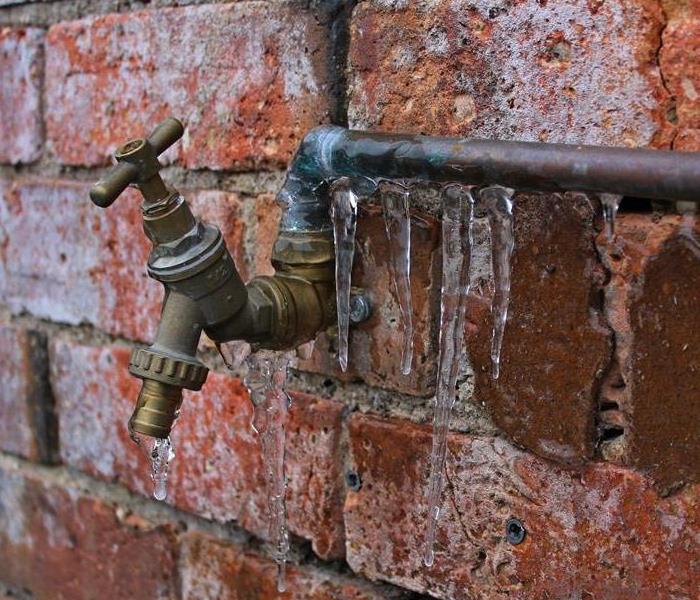 A frozen pipe runs along the outside of a brick foundation.
A frozen pipe runs along the outside of a brick foundation.
Last year, Bergen County and the entire Northeast suffered a deep freeze of below-freezing temperatures for nearly two weeks. This resulted in frozen and bursting water pipes in many homes, offices, and schools throughout the region.
Thankfully, SERVPRO of Hackensack/Little Ferry was on the scene, helping many homeowners and businesses by extracting water and drying basements, crawl spaces, floors, and sheetrock.
According to the Old Farmer's Almanac, this winter is predicted to be warmer than normal but also wetter than normal. No matter what the actual weather will be, it is important to make sure your home is prepared for winter.
To avoid frozen and broken pipes, it is easy to take the following steps:
Outdoors:
- Wrap outside faucets
- Caulk around pipes where they enter the house
- Disconnect garden hoses
- Drain in-ground sprinkler systems
Indoors:
- Let a trickle of water run if the temperatures dip below freezing
- Open cupboard and vanity doors in the kitchen or bathroom. This little bit of airflow makes a big difference.
- Make sure the thermostat is set to a constant temperature
If, however, you do experience broken pipes or water damage this winter, make sure you take quick action to have the water extracted and your home or business dried out properly. Call SERVPRO of Hackensack/Little Ferry and we will make it “Like it never even happened.”
Flood Damaged Floor Repair
9/30/2022 (Permalink)
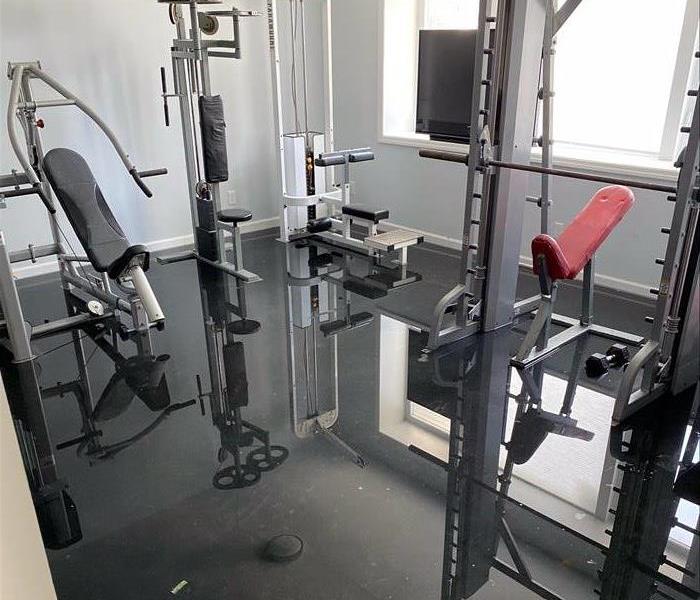 An NJ home gym was flooded by water.
An NJ home gym was flooded by water.
Storm surges can be dramatic and cause significant damage but with the proper tools and training, it doesn’t have to mean a total renovation. The only good thing about storm surges is that the waters often recede as quickly as they rush in. Hardwood flooring that is properly protected with polyurethane can withstand water penetration if remediation happens quickly. At SERVPRO we have the right equipment and training to often save hardwood floors instead of removing them. Here are three techniques we use.
First, our injecti-dry panel system is one way to extract moisture. Our technicians use plastic sheeting to create a containment area and install dehumidifiers to regulate the moisture levels. The panels are installed with special methods to reduce additional damage. We then use moisture measuring meters to monitor the changing moisture levels all the way to the subfloor.
Second, we may utilize a heat drying system that heats the material to approximately 100 degrees. Heat ducts are installed to remove the humid air and infrared monitors are used to monitor the drying process.
Finally, a Desiccant Dehumidifier may be used to introduce outside air which is passed through a dehumidifier before being introduced to the material. Again, moisture monitoring equipment is used to measure the progress and reduce moisture at a controlled rate.
If you experience flooded floors call us to see if one of our methods can be used to save the material before you begin removing any material.
Drying hard wood floors
5/27/2022 (Permalink)
 Water from the bathroom caused damage to this floor. Luckily it was dried and repaired instead of being removed.
Water from the bathroom caused damage to this floor. Luckily it was dried and repaired instead of being removed.
Water damage to hardwood floors can be tricky. SERVPRO of Hackensack/Little Ferry has the ability and equipment to save your hardwood floors if it is addressed quickly. After our technicians have accessed the loss and determined that the hardwood floors can be saved, will set up our specialized equipment. Insurance companies and adjusters like it when we can save the floors because it is more cost-effective which in turn keeps down premiums. The floor drying mat system removes the excess water from underneath the hardwood floors. Stabilization takes between two to six days but in some cases may take longer. The goal is to remove the visible cupping and to get as close to appropriate equilibrium moisture content without overdrying. If you encounter water damage and your wood floors are affected, please call SERVPRO for a free consultation. We will respond quickly and help you with your loss and make it, “Like it never even happened.”
Proper Water Remediation
1/31/2022 (Permalink)
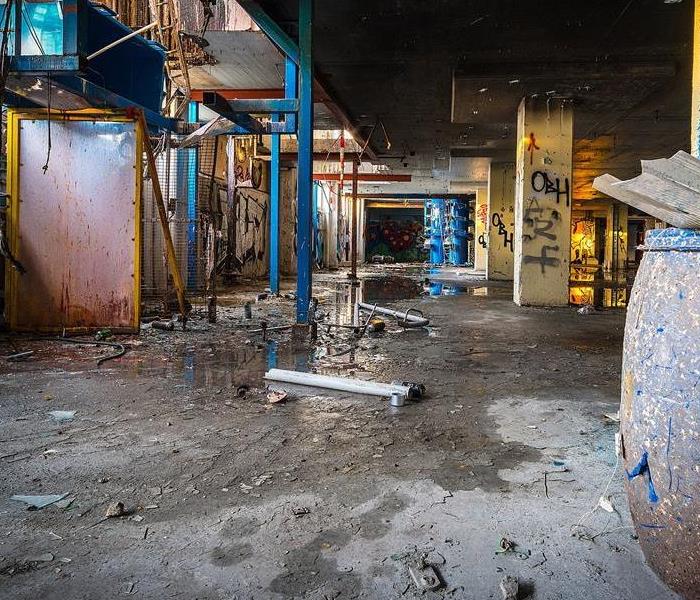 Water damage in a warehouse.
Water damage in a warehouse.
According to Wikipedia, wastewater is any water that has been affected by human use. But did you know that there are different grades of wastewater? Should your home be affected by water damage, it is imperative to act quickly to mitigate damage and prevent further damage such as mold growth.
CLEAN WATER
Floodwater that does not pose an immediate health threat is known as clean water. Clean water floods can result from malfunctioning appliances, toilet holding tanks, and melting snow and rainwater. Clean water home floods are generally safe for you to clean up yourself, but remember--time is an important factor. Standing clean water can become greywater if left untreated.
GREYWATER
Greywater refers to wastewater that is not contaminated with fecal matter. As far as household wastewater goes, greywater could include water from bathtubs and showers, appliances such as dishwashers, a weather event, an overflowing plumbing fixture or appliance or even a broken pipe.
When flooding occurs, it can saturate carpeting, furniture and drywall. If you experience a home flood with greywater, wear protective gear, and keep children and pets away from the flooded area. If the flood is extensive, such as several inches of water in the basement, it is advisable to hire professionals to safely clean up and decontaminate the area. Cleanup must begin as soon as possible as greywater can become blackwater if left untreated.
BLACKWATER
Blackwater is wastewater contaminated with human waste, floodwater, or water contaminated with chemicals.
Blackwater floods are the most dangerous and the most destructive and must be cleaned and mitigated immediately. Because of the unsanitary conditions of the water, items such as carpets, upholstery, and drywall are often unsalvageable. Contact with blackwater can cause illness in both humans and pets.
Having water damage in your home is never a pleasant experience, and oftentimes it is destructive, and disruptive - affecting multiple rooms, floors, levels – of a home, office, or multiple dwelling. Knowing whom to call and when could mean all the difference in keeping contamination and damage to a minimum.
Remember that you can call SERVPRO of Hackensack/Little Ferry twenty-four hours a day, 365 days a year. We will be there to survey and clean up your water damage quickly and get you back to your normal routine as quickly as possible.
Leaking Hot Water Heater?
1/31/2022 (Permalink)
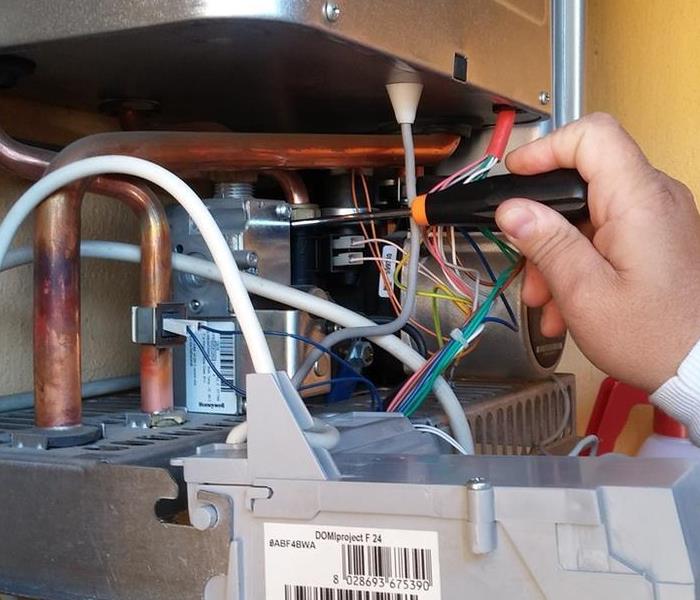 Performing maintenance on a hot water heater.
Performing maintenance on a hot water heater.
Sooner or later everyone will experience a leaking hot water heater. But this minor emergency doesn’t have to become a major disaster.
Here’s a list of steps you can take to minimize the damage from a leaking heater:
Confirm that it is, in fact, your water heater that’s leaking.
Sometimes looks can be deceiving. If you see a puddle of water under your hot water heater, it’s obvious why your first thought would be a heater leak. But that may, in fact, not be the problem.
If it’s a small puddle, your first step should be to clean up the water and inspect the heater. Do you see any wet fittings or other signs of leakage from the tank itself? Check your surroundings for other water sources? Maybe there’s a nearby window or pipe that is the actual source of the water you see. Don’t forget about the effect of gravity! If your floor slopes, the water may have traveled from a different source point to the place where it ultimately pooled.
Turn off the water.
If you do have a leaking water heater, the next recommended step is to turn off the water.
Your hot water heater should have its own shut-off valve.
If your valve is broken, you may need to shut off the water to your home. If you need assistance, reach out to your local expert professionals.
Cut the power.
Whether you have a gas or electrically powered water heater, your next step is to shut off the fuel source that powers your heater.
A gas tank should have its own dedicated shut-off gas valve. You want to make sure the gas is off so your heater will be safe to work with. If you have an electric tank, you can shut off the power at the breaker.
Try to determine the location and cause of the leak.
Now that the water and power are off, you will be in a better position to assess your situation and try to determine the location and course of your leak:
Check the pipes that connect to your heater for any loose fittings. This may just require quick tightening with a wrench.
- Check your pressure relief valve. If the temperature or pressure is too high, this could be causing valve leaks. Your water heater should be around 120 degrees Fahrenheit and the pressure shouldn’t be over 80 PSI.
- Check the drain valve to make sure it doesn’t need replacing.
- Check the bottom of the water heater itself -- it may be that the tank itself is cracked and needs to be replaced.
If you determine that it is your tank that is leaking and the leak is serious, you may want to drain the tank to minimize further water damage.
Hopefully, the leak from your hot water heater hasn’t caused too much water damage. But if you need professional assistance, the restoration pros at SERVPRO of Hackensack/Little Ferry are here to help. We’re equipped to handle any size water damage restoration needed for either residential or commercial buildings.
Cleaning a Flooded Basement
1/31/2022 (Permalink)
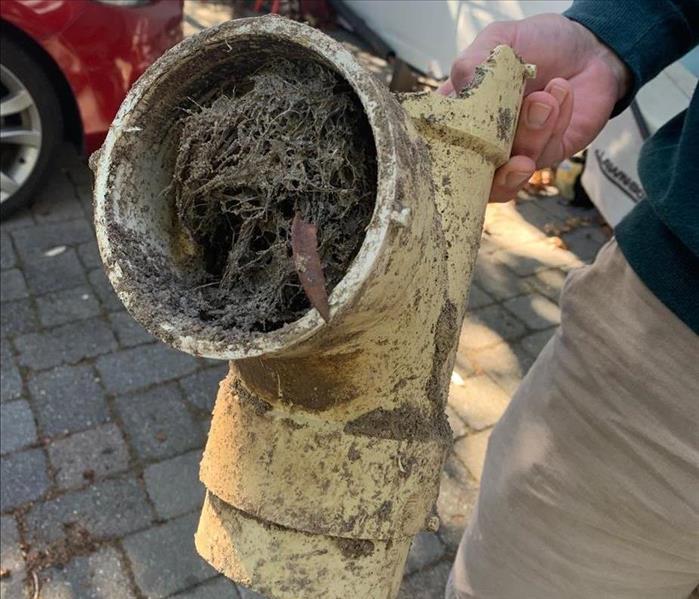 Tree roots penetrated this sewer line causing it to back up into the basement.
Tree roots penetrated this sewer line causing it to back up into the basement.
Groundwater flooding is basically water in your basement caused by seepage or flows through the walls or foundation floor.
According to State Farm Insurance, there are four common sources of water entering basements. Each source has its own specifics and requires its own course of action.
Surface water running down foundation walls.
If this is the first instance of water problems in your basement, the first thing to check for is surface water draining down next to the foundations. Water coming in at one location or only at the exterior foundation wall indicates surface water problems. Here are some things to look for once you get outside.
- Overflowing gutters: leaves
- Overflowing gutters: downspouts
- Downspout distance
- Pavement slope
- Sealant
- Landscape slope
- Irrigation
Groundwater in water-saturated soils is being pushed into the basement by hydrostatic pressure.
If no surface water sources are found, then the source of the water is likely subsurface groundwater under hydrostatic pressure. When the groundwater levels outside the basement rise above the level of the floor, the basement acts like a boat in a pond. If a boat is sitting in water, water will leak in through any open cracks or holes. It works the same way with a basement. Hydrostatic pressure can push water through hairline cracks.
Unfortunately, subsurface groundwater problems are more difficult and more expensive to fix than surface groundwater problems.
Storm sewer water from the municipal storm sewer system backing up into the home's existing perimeter foundation drain and leaking into the basement.
If you have an older house within town and the house has a basement with no sump pump, it is likely the perimeter foundation drain system connects directly into the city storm sewer system. If the level of the basement is below the street level, there is the potential of stormwater backing up in the city storm sewer system and being pushed into the perimeter foundation drain system. This can saturate the soils around the house at the basement level with stormwater under hydrostatic pressure, causing water to leak in.
- Underground springs
- Stormwater backing up
- Sewer water backing up
Sanitary sewer water from a clog in your home's sewer line. If there is a clog in the municipal sewer line, or the combined municipal storm/sanitary sewer system backing up into the home's drain system, it can cause sewer water to come up through sink drains and floor drains on lower levels.
Whatever the cause of water in your basement, remember it is important to have it dried out as soon as possible by a professional. SERVPRO of Eatontown/Long Branch is available 24/7 and will be able to get to your water damage quickly.
Training for Excellence
1/29/2022 (Permalink)
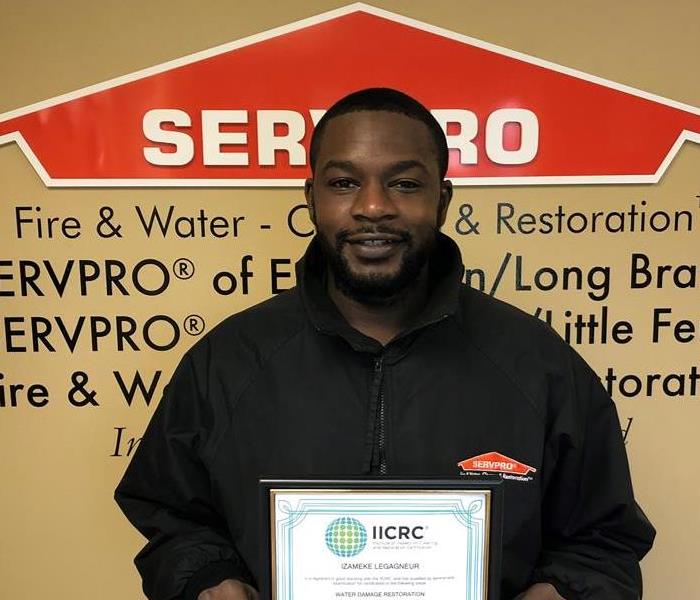 Meek holds his latest certification as a Water Damage Technician.
Meek holds his latest certification as a Water Damage Technician.
Congratulations to our technician, “Meek,” on completing his certification as a Water Damage Technician from the IICRC. At SERVPRO of Hackensack/Little Ferry, we believe in service excellence and that begins with having professionally trained team members. We don’t hire “laborers.” We employ “Technicians” and invest in their training to tackle even the most challenging jobs professionally. This particular certification from the Institute of Inspection Cleaning and Restoration Certification is the gold standard in the restoration industry. Our team members are constantly taking courses to stay current on the latest trends, techniques, and tools of the trade.
Take a look at our reviews and you will consistently see comments about our professionalism in action. We take pride in these skills and our ability to make someone’s mess, “Like it never even happened.”
Proper Water Remediation
10/29/2021 (Permalink)
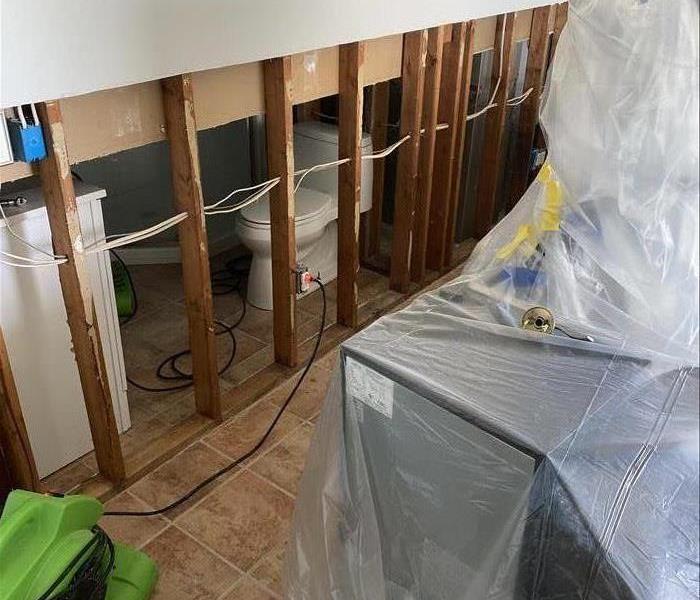 Significant damage caused by a backed-up HVAC system.
Significant damage caused by a backed-up HVAC system.
At SERVPRO of Hackensack/Little Ferry, our expert technician’s first job is to educate.
When a burst pipe or leaky roof damages your property, It is time to call SERVPRO. Our technicians take the time to explain in detail all aspects of the job prior to commencing services so you understand the issues that need to be addressed and the process/methods we will use to address the damage.
- The consequences of delaying or failing to “mitigate” the damage
- The steps we expect to complete while limiting the harm and moving towards SERVPRO’s ultimate goal of making it “Like it never even happened.”
What Is Water Mitigation and Why Does SERVPRO Address It Before Other Tasks?
Water mitigation is one or more strategies to halt ongoing water damage. Because water is incredibly corrosive, prompt mitigation is essential a wide range of water cleanup issues caused by damage like basement flooding or leaking roofs from storms. Mitigation in a water-damaged home can include:
- Shutting off water supply lines
- Pack-up and removal of soaked home contents
- Use of professional-grade wet vacuums to create a dry zone around the perimeter of water in carpeting
- Water removal services using pumps and or portable extractors
- The use of controlled demolition to release trapped water
What comes after Mitigation?
Water mitigation moves on to remediation and water damage repairs as the moisture diminishes. The goal of “restoration” is why SERVPRO’s customers reach out initially, but grasping that mitigation is part of a more extensive process helps residents allow the phases to follow in a logical and research-based progression.
Training, honesty, and integrity, plus top-of-the-line equipment are SERVPRO of Hackensack/Little Ferry fulfills our promise to return a water-damaged home to safe and sanitary conditions.
Managing an overflowing toilet
10/29/2021 (Permalink)
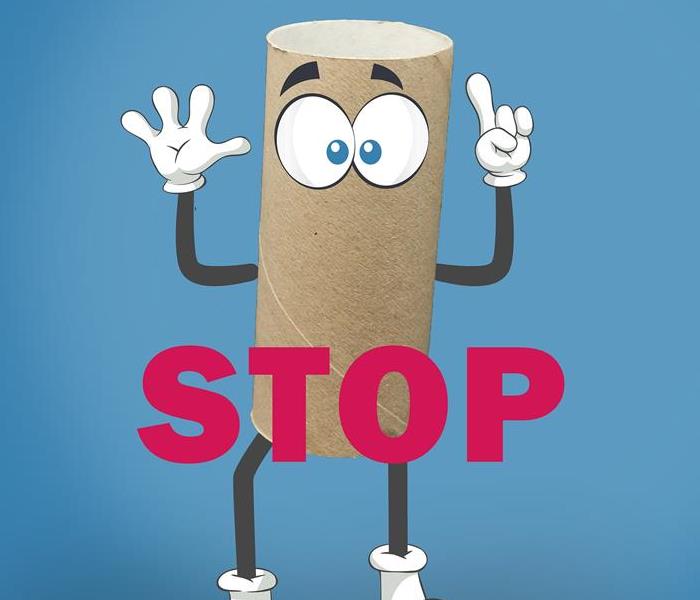 Toilet paper roll animation
Toilet paper roll animation
We’ve all been there! Clogged pipes, leaky faucets, and overflowing toilets are all common enough problems that you shouldn't be too surprised when happening to you. The toilet overflow presents a messy challenge for homeowners because it introduces the possibility of sewer damage. If your toilet starts running over, consider following these basic steps.
- Stop the water. Your first priority should be to stop the water. Most toilets have a shut-off valve at the base. Check to see if your fixture has one. If not, you can stop the water by manually manipulating the float valve in the tank. If all else fails, you can turn off your home's water and turn on the faucet at the lowest point in your home until the water stops.
- Get some help. Once the initial onslaught of water has been stopped, you need to call in a water restoration expert to help you assess the damage. This professional can help you figure out why the toilet started to overflow. The team will also create a sewer damage cleanup plan to help you get your bathroom back to normal.
- Remove the water. Leaving standing water in any part of your home is unwise. The water damage team will likely remove the water as soon as they can. This helps reduce the secondary damage, such as mold growth and material contamination, that can happen as a result of a flooded toilet.
- Fix the toilet. Chances are your toilet overflowed for a reason. The most common reason is a clog. Work closely with a plumber to remove the blockage from the pipes.
Hazards of Storm Water Flooding
9/30/2021 (Permalink)
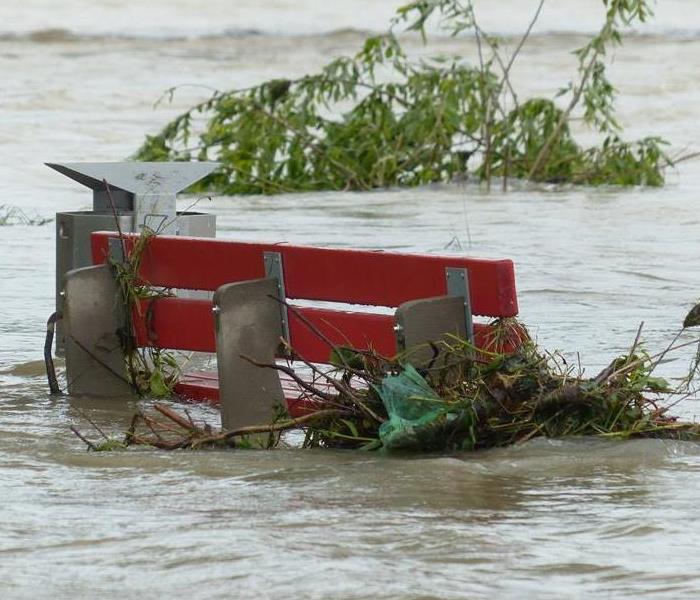 Park bench in flood water with debris pinned against it.
Park bench in flood water with debris pinned against it.
Almost a month after the remnants of Hurricane Ida hit NJ, many property owners are still dealing with the mess. We have been working 7 days a week to help as many people as possible. Our teams are bolstered by the support of multiple SERVPRO teams from out of state, and it is still not enough. Many homeowners have been tempted to handle the cleanup themselves but there are some serious considerations if you are going to do so.
First, make sure the area is safe. Downed wires and electrocution hazards need to be addressed before any work is done. If significant flooding has occurred, both the electrical service and gas should be shut off to prevent an explosion or electrocution. Sharp items such as broken glass must be removed to prevent puncture wounds and cuts which are highly prone to infection. Be aware of any displaced animals such as snakes. Always wear PPE such as rubber boots, gloves, and goggles.
Second, floodwater is contaminated. A river that has overflowed is carrying more than just the usual stream water. Flooding has washed contaminants downstream which may include:
- Human and livestock waste
- Household, medical, and industrial hazardous waste (chemical, biological, and radiological)
- Coal ash waste that can contain carcinogenic compounds such as arsenic, chromium, and mercury
- Other contaminants that can lead to illness
- Physical objects such as lumber, vehicles, and debris, or needles
- Wild or stray animals such as rodents and snakes
Third, exposure to contaminated floodwater can cause:
- Wound infections
- Skin rash
- Gastrointestinal illness
- Tetanus
If you experience any of these symptoms seek immediate medical attention.
For more information on the health concerns after a flood visit the CDC website at Floodwater After a Disaster or Emergency | CDC
Proper Water Remediation
9/30/2021 (Permalink)
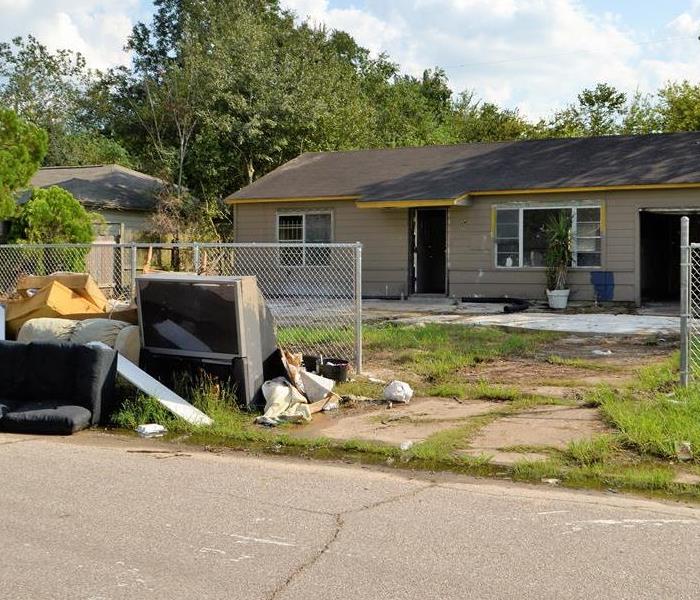 A home damaged by water in a storm
A home damaged by water in a storm
Even small water damages have the potential to cause serious structural and indoor air quality issues over time.
The key to avoiding costly future restoration is to handle every water problem as a real threat to your property. The proper equipment makes a huge difference in reducing the damage expense during a water loss. When time matters most, technology and equipment can be counted on.
Here are a few tools used by SERVPRO of Hackensack/Little Ferry to properly mitigate a loss;
Moisture Sensors- used to detect moisture in carpets, baseboards, and walls.
Moisture Meters- used to determine the actual moisture content of various materials. The meter provides accurate readings to monitor the drying process.
Thermo Hygrometers- measures temperature and relative humidity to calculate and create an environment most conducive to drying. When handling a contaminated loss (CAT 2 or 3), it is not only important to dry the structure, but disinfect and deodorize.
Ultra Low-Volume (ULV) Foggers- used to atomize liquid deodorizing agents, producing a fine mist that can easily penetrate the site where odor-causing residues may accumulate. It can also be used to inject fungicides and disinfectants into wall cavities and other hard-to-reach areas.
Thermal Foggers- dispenses solvent-based products by creating a dense fog that consists of tiny particles of deodorant solution that attach to and neutralize odor-causing particles.
The bottom line... ALWAYS treat water damage seriously. Call in a professional team like SERVPRO of Hackensack/Little Ferry. We will work for you to restore your property and your life to make it "Like it never even happened."
Wet Memorial Day Weekend
5/28/2021 (Permalink)
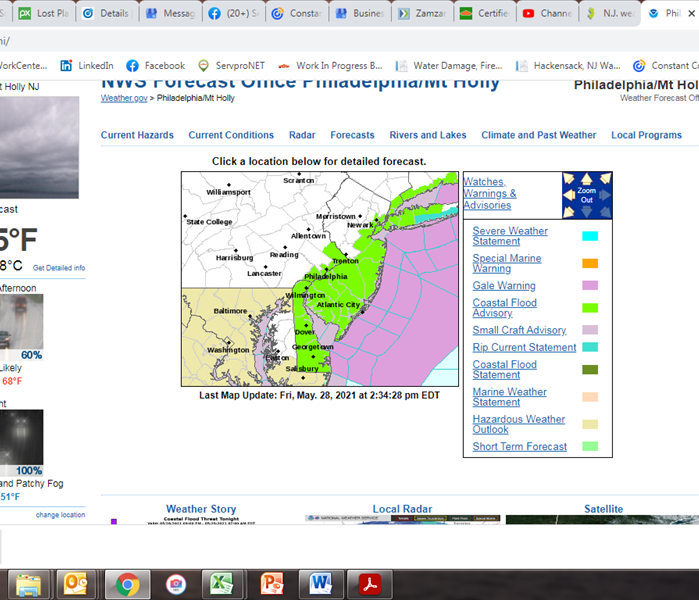 It is going to be a wet Memorial Day weekend!
It is going to be a wet Memorial Day weekend!
It is going to be a very wet Memorial Day Weekend. Hopefully, we will catch a break on Monday and be able to get out to honor our veterans. In the meantime, take a moment to prepare for significant rain and possible flooding. The National Weather Service is forecasting a couple of inches of rain across NJ with the potential for flooding along the coast, rivers, and low-lying areas.
As the first heavy rains of the season approaches, here are some quick tips to check and prevent water damage:
- Check your gutters and downspouts – if you have had any new landscaping or mulch installed check to make sure the water will flow freely away from the structure
- Check your basement sump pump to make sure it is operational
- Make sure items are on shelves or otherwise raised off of basement/ flood prone floors
- Make sure the patio furniture you just put out is secured
- Turn off the gas line to your grill
If you experience any water damage rest assured that SERVPRO will be ready to respond and provide assistance 24/7/365.
Have You Had Water Damage in Your Home?
1/28/2021 (Permalink)
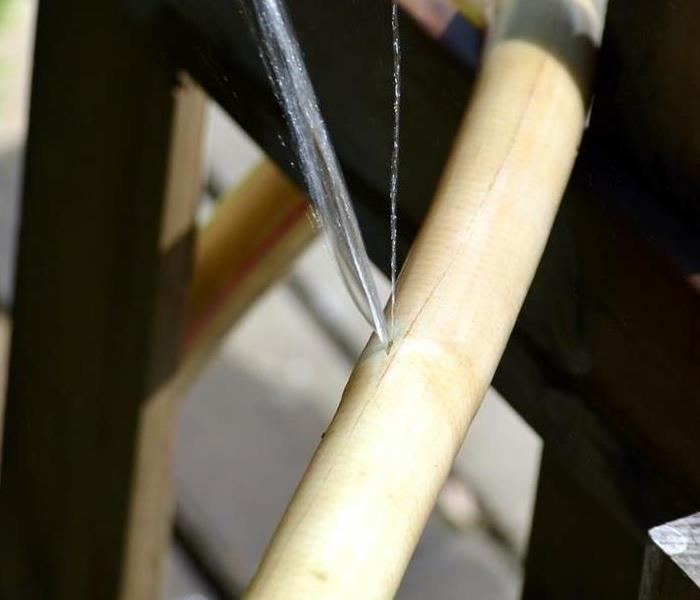 Water Spraying from a Leaking Hose
Water Spraying from a Leaking Hose
Have you had water damage in your home? On average, homes experience water damage once every 11 years. This damage is caused by a variety of sources, most of which can be mitigated through periodic monitoring and maintenance. Here are some tips to help you find some of the routine causes.
Gutters
- Make sure the gutters are not clogged by leaves and debris. This will cause standing water that can freeze and cause ice dams. For more information on ice dams click on this related blog Ice Dams
- Downspouts need to be extended far enough away from the house to prevent water from entering the basement
Plumbing
- Look for leaks under your refrigerator. Not only does removing dirt help improve the unit’s efficiency but the water supply line to the ice maker can come loose and cause a leak that is hidden due to its location. As a side note, I experienced a leak here about a year ago due to a mouse chewing on the supply line.
- Washing machines often have very old and degrading supply lines. Is yours appear worn you should consider a new set which are easy to install. Look for the ones that have a metal mesh around them for added reinforcement
- Dishwashers also have water supply lines and can have issues similar to ones noted in the refrigerator section.
Sinks
- As above, check the supply lines for leaks.
- Check the drain, especially the S-trap under the sink to make sure it hasn’t wiggled loose after being bumped by items stored in this space
Humidifiers
- One last time, check the supply lines. These units should be turned on in the fall and off in the spring at the closest valve to limit the risk of leaking during the warm weather.
If you experience water damage, call the experts at SERVPRO of Hackensack/Little Ferry at 201-441-1345.
What Type of Water Is It?
1/27/2021 (Permalink)
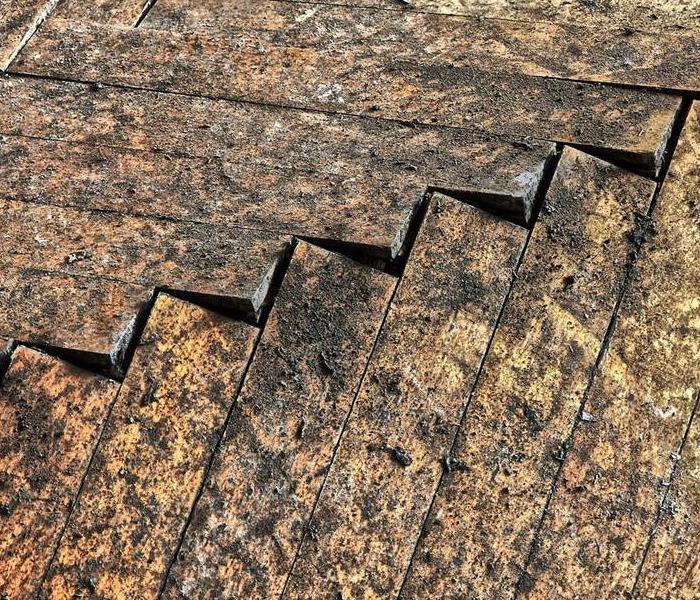 Boards after water damage
Boards after water damage
What type of water is it? No, sparkling or tap are not options when it comes to water damage. There are 3 classifications of water when it comes to flooding: Clear, Gray, or Black. These are not exact terms but designed to give an indication of the level of contamination within each.
Clear Water originates from water pipes such as water mains or plumbing in your home. It is always essential to remove the water as quickly as possible but clear water is the easiest because there are reduced safety procedures involved.
Gray Water is water which may have contamination. Therefore, a moderate degree of care and safety precautions are warranted. This water may come from storm damage or flood damage from more natural sources.
Black Water is the most serious and dangerous. SERVPRO technicians are trained in handling this material, along with many other biohazards. Typical sources may include septic tanks or waste water pipes that have ruptured. This type of water causes the most dangerous due to the microbial parts it contains and the accompanying health effects of exposure. Don’t tackle these situations yourself. Call the experts at SERVPRO!
You Will Thank Me One Day
1/20/2021 (Permalink)
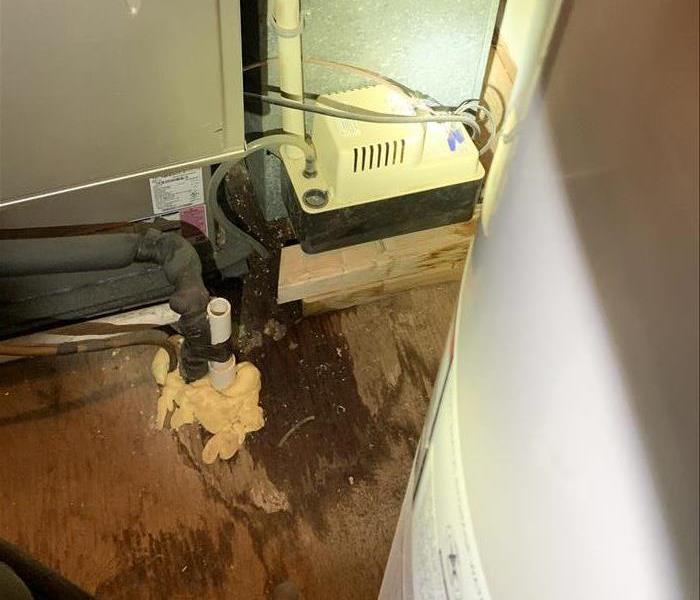 Water pooling from a leaking furnace exhaust
Water pooling from a leaking furnace exhaust
How often do you check the mechanical closet/spaces in your home? If you’re like me, you are proud of yourself if you remember to change the air filter even once a year. Like many issues that arise with home ownership, an ounce of prevention is worth a pound of cure.
I recently went into my mechanical closet to get a folding chair and noticed water on the floor. “Where did that come from,” I wondered. It wasn’t the hot water heater or near any plumbing. It was next to the furnace (see image). While the amount of water was fairly minimal, it would certainly result in a deterioration of the plywood flooring and create a breeding ground for mold.
I had my HVAC contractor come and the cause was a tiny hole in the exhaust flu. When the weather turned cold the moisture in the exhaust condensed and ran back down the flu, leaking out onto the floor. I paid $99 for the service call to have it repaired.
The lesson: check your mechanical areas periodically to look for signs of water, mold, or other mechanical issues that could result in more significant issues if not addressed. You will thank me one day…
It's Just Water
1/18/2021 (Permalink)
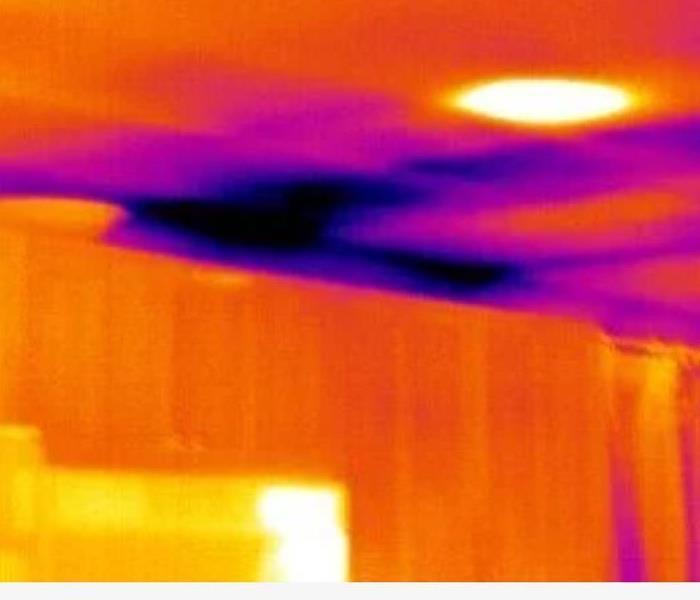 Water damage visible when viewed through a Thermal Imaging Camera
Water damage visible when viewed through a Thermal Imaging Camera
It’s just water, but it makes a huge mess! Even a small leak can create a massive amount of damage and pose serious health concerns for the long term. It is important that those cleaning up water damage have the proper training and equipment. This is not a job for your typical general contractor!
The cosmetic aspects of a remediation project are fairly obvious to identify but what about what you can’t see? Water saturated insulation, flooring, and sheetrock can be a breeding ground for harmful mold that may not become apparent for a long time. This growth may also cause health issues including respiratory and auto-immune issues.
One way SERVPRO uses technology to assess the extent of water damage is with a Thermal Imaging Camera (TIC). This roughly $2,000 piece of equipment uses varying colors to show heat changes, making dampness visible. A local handyman or general contractor will not have this type of technology.
Wet areas in the building material do not warm and cool the same way adjacent dry areas do and this makes them visible when looking through a TIC. The photo shown here is from recent water damage at a local school here in NJ. To the naked eye the area shown appeared to be undamaged. However, when viewed as a thermal image the pattern of water soaking into the material from the flooded floor above becomes apparent. Had this area not been removed and replaced it could have created mold issue for the staff and students.
Don't Ruin Your Vacation
1/13/2021 (Permalink)
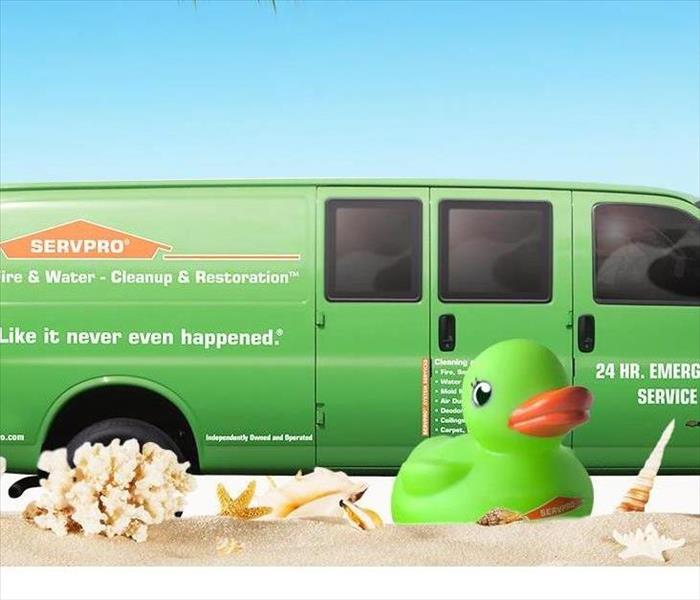 Oh, I'd like to be that van!
Oh, I'd like to be that van!
Are you looking forward to going on vacation again? Our family’s “Spring Break Trip” looks like it is going to be cancelled due to Covid, so my wife (Happy Birthday!) wants to take a road trip to FL. I love vacation but I always have that voice in the back of my head wondering if I set the alarm, locked the doors, and did my wife unplug the hair straightener (yes honey, I love you, and it’s your birthday, but this is a legitimate concern). But, what else am I forgetting? What about Water damage?
Before you leave, it is important safeguard your home from possible water damage. Here are some easy steps to protect your home and prevent vacation from being cut short due to a disaster.
Take a proactive look before you leave
Check for leaks in your plumbing, focusing on the pipes and connection you can see inside your house. The weakest points are places where hoses connect to taps or household appliances. Check under sinks for signs of leakage and rust and around water heaters, dishwashers, furnaces, and washing machines
Turn off the Water Supply
Shut off the water supply to the home and the hot water heater itself. Not only are hot water heaters a major culprit of water damage but there is no need to keep 75 gallons of water piping hot while you are away. Even a small leak, from a toilet supply line for example, can cause a massive amount of damage if not detected quickly (See our Facebook post from 12/4 at Simple toilet leak - NJ).You may also choose to, additionally, shut off the valves at your toilets, appliances, washers, and dishwashers.
Are There Different Types of Water Removers for Damaged Homes?
10/7/2020 (Permalink)
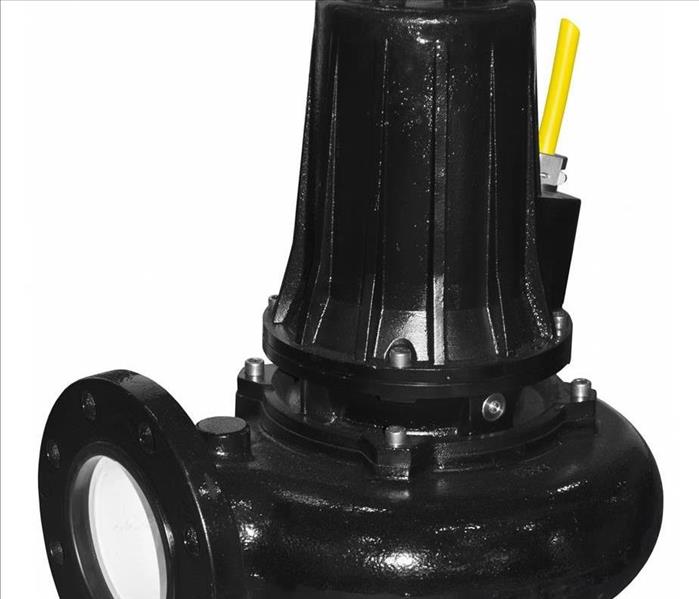 SERVPRO Provides Advanced Water Removal Equipment to Mitigate Damage to Hackensack Area Properties
SERVPRO Provides Advanced Water Removal Equipment to Mitigate Damage to Hackensack Area Properties
Our SERVPRO team utilizes a full inventory of restoration and recovery tools to help your water-damaged Hackensack home.
Meeting the needs of a water-damaged Hackensack property means understanding the changes from one site to the next. A pipe burst from freezing temperatures requires different tools and approaches than a leaking fixture underneath a sink. We have a comprehensive inventory of recovery tools to help.
Because water damage in Hackensack homes can be so destructive when not thoroughly addressed, we rely on multiple types of tools to manage various aspects of this restoration. Among the most pressing of these is removing standing water and trapped water in structural elements throughout the property, as this can lead to damaging situations like microbial growth and deterioration. Some of the different extractors that our professionals use include:
- Electric Submersible Pump – Electric pumps are among the most common option for our restorers, offering quiet and continuous operation. Typically deployed with standing water depths of two inches or more.
- Self-Priming Trash Pump – When solids and small bits of debris are a possibility in the water, these powerful pumps can help manage the standing water threats.
- Light Wands – Attachments for wet vacuums are necessary for water removal, as many of the impacted areas are not highly accessible.
- Weighted Extractors – Stand on units use our technicians' weight to force moisture to the surface of carpeted floors for extraction. Drying in place is a key element to salvaging wet carpets.
What Tools Get Used for Thorough Drying?
Drying is ultimately one of the most necessary elements of any water restoration project. While air movers and dehumidifiers remain the foundational blocks of this phase, we can also use special tools like positive and negative pressure systems, floor mat drying systems, and portable heaters.
Water restoration does not have to be overwhelming for homeowners. Our SERVPRO of Hackensack / Little Ferry team is standing by 24/7 to help when you call (201) 614-2600.
SERVPRO of Hackensack/Little Ferry - 24 Hour Emergency Water Damage Service
5/22/2020 (Permalink)
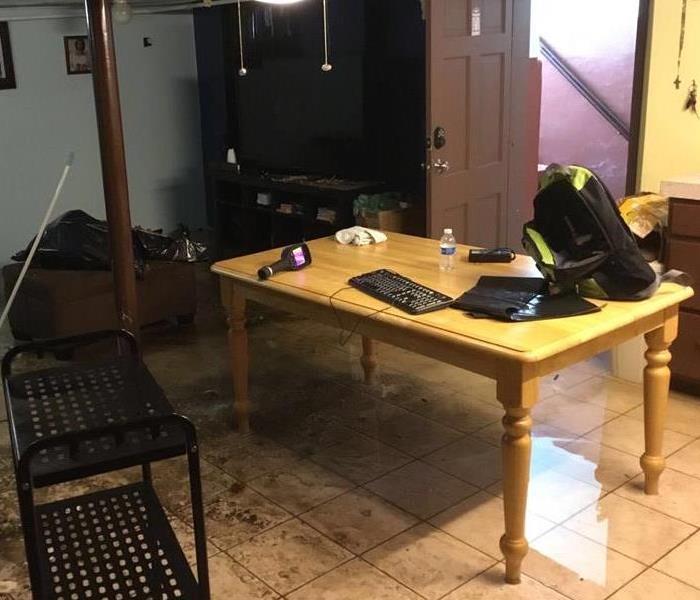 Water damage in a customer's home.
Water damage in a customer's home.
SERVPRO of Hackensack/Little Ferry is available 24 hours a day for water emergencies, large or small. When you are dealing with water damage, immediate action is crucial. A delay of just a few hours can greatly increase the severity of the water damage.
We Answer the Phone Ready to Help
Call Today - 201-742-5920
We understand that when you call us, you may be feeling confused, stressed, and vulnerable. You need an expert to guide you through this crisis. SERVPRO of Hackensack/Little Ferry has the specific water damage training and experience to help you through this tough time. We specialize in water damage restoration—in fact, it's the cornerstone of our business.
What to Expect
When you call, we will ask several questions regarding your water damage emergency. These questions will help us determine what equipment and resources to bring, including how many trained SERVPRO Professionals may be needed.
Our SERVPRO Representative will ask several questions:
· Your name and contact information
· Your insurance information (if applicable)
· The street address of the water-damaged home or business
· When did the flooding or water damage occur?
· What caused the water damage (if known)?
· Is there electricity available (on-site)?
About SERVPRO of Hackensack/Little Ferry
SERVPRO of Hackensack/Little Ferry specializes in the cleanup and restoration of residential and commercial property after a fire, smoke or water damage event. Our staff is highly trained in property damage restoration. From initial and ongoing training at SERVPRO’s corporate training facility to regular IICRC-industry certification, rest assured our staff is equipped with the knowledge to restore your property.
How to Clean Up the Water Damage After a Burst Pipe
1/16/2020 (Permalink)
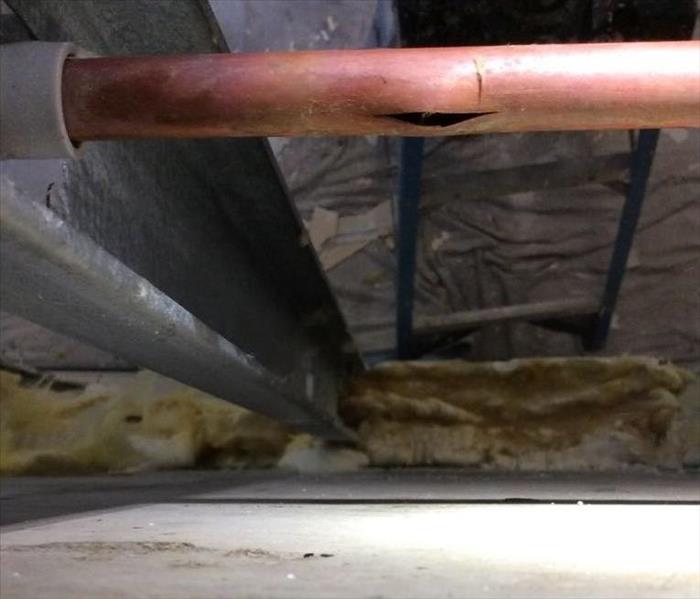 A frozen pipe like this one can send gallons of water into your home, ruining floors, walls, ceilings, and possessions.
A frozen pipe like this one can send gallons of water into your home, ruining floors, walls, ceilings, and possessions.
A burst water pipe can be disastrous. You could end up with a flooded floor and severe water damage to your costly possessions and property. It can be overwhelming.
Here at SERVPRO Hackensack / Little Ferry, we know how important it is to act fast when you’re dealing with a burst pipe. Unfortunately, the cold weather season is when burst frozen pipes are most common. So, we want to make sure you’ll be prepared.
Here’s what needs to be done to effectively clean up the water damage:
Shut Off the Water
Once your pipe bursts, water will flow continuously until you shut off the water supply. To do this, locate and turn off the main shutoff valve, typically located in a basement or utility room.
Repair the Pipe and Restore the Damage
Remove Damaged Items
Usually a plumber will come and take care of repairing the damaged pipe. This needs to be done before any restoration work can begin.
Your next step is to remove any wet and damaged items from the area. If there are any wet items you want to try to salvage, try to start drying them as quickly as possible. Damaged items should be disposed in order to prevent mold growth and contamination.
It’s also a good idea to move any additional furniture and/or any important personal items away from the affected area, just in case.
Remove Water
Extract the standing water from the area as quickly as you can.
You can start with a wet-dry vac, just be sure to keep emptying the storage tank so that it won’t overflow. SERVPRO has professional-grade equipment that will extract even what a wet-dry vac can't.
Pro tip: NEVER use a vacuum cleaner, as they are not meant to deal with water and could pose an electrical hazard.
Dry
Once as much water is removed as possible, the drying process is begun by using both fans and dehumidifiers.
SERVPRO uses commercial-grade fans, as these will dry out the area faster, which is important in order to minimize the total damage.
Pro tip: if a carpeted area got flooded, make sure to lift the carpeting off the sub-flooring in order to speed up the drying process. Unfortunately, your carpet padding will unlikely be salvageable, but at least it’s relatively inexpensive and simple to replace.
How You Can Prevent Winter Water Damage
12/27/2019 (Permalink)
Winter can be a prime time for water damage, especially during days when temperatures change, causing ice and snow to start to melt. Or - what happens if freezing temperatures cause one of your pipes to burst?
Here at SERVPRO of Hackensack/Little Ferry, we’ve seen how water damage can be especially disastrous to homes and businesses during wintertime, and we know the most common causes of winter water damage. Luckily, if you know what to look out for, you can proactively prevent many of the worst kinds of water damage.
Here are five of the most common causes of winter water damage, and what you can do to keep your property and belongings safe.
Bursting Pipes
- Sudden drop in temperatures causes a pipe to break open. Make sure your pipes are insulated.
- Small leaks that grow larger unnoticed over time. Make sure to check your pipes for signs of damage or wear and tear.
- Check that hoses and supply lines are tight to prevent slow leaks.
- Turn off water supply to outside lines during the winter.
Worn Out Chimneys
- Damage to the brickwork of your chimney could cause leaks inside the chimney itself or to your attic or basement. Check for loose mortar between the brick, and also be on the lookout for any signs of water stains.
- Your chimney liner and a cap could also allow leaks because they can wear out over time. Make sure you check them periodically.
Worn Out Caulking
Most doors and windows are sealed with caulking, which is there to prevent drafts and inclement weather from entering inside. However, as temperatures rise and fall, caulking will naturally expand and shrink and eventually wear out over time.
It’s a good idea to check your caulking for cracks and damage at least once a year, ideally before the worst of the winter weather hits.
Worn Out Roofing
If the seams and flashing on your roof are worn out, this could lead to leaking and water damage when snow starts to melt.
Ice Dams on the Roof
Perhaps the most common cause of winter water damage is from ice dams that form on the roof. Many people don’t even notice as ice and water repeatedly thaw and refreeze and start to form an ice dam along the edge of the roof.
One of the tell-tale signs of an ice dam is a group of icicles hanging down. In order to prevent ice dams, you can add extra insulation to prevent dramatic temperature swings on your roof. Check for water stains in the wood, and make necessary repair to prevent future leaks.
Keeping up on your home repairs and regular inspection of your pipes, roof, chimney and gutters will give you an advantage when the cold weather strikes. If you still need us, we are open 24/7 always available.
Don't Forget Your Plumbing
12/10/2019 (Permalink)
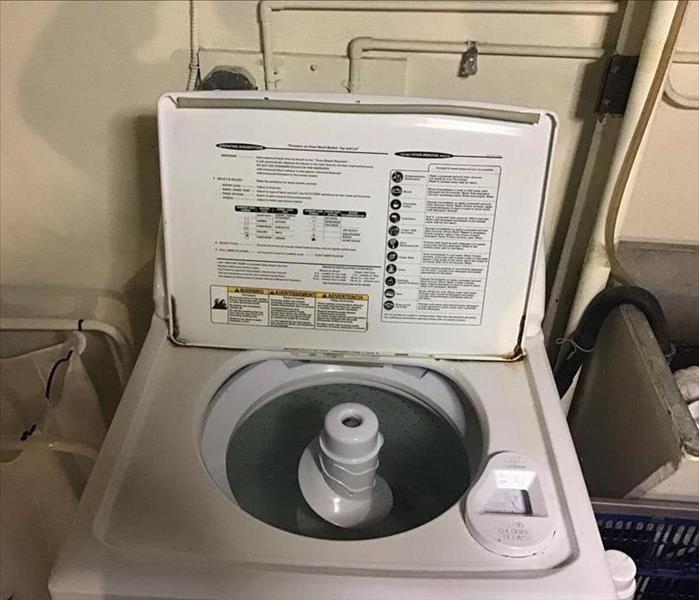 Washing machine hook-ups are a major plumbing issue, especially if the hose is broken, loose or damaged.
Washing machine hook-ups are a major plumbing issue, especially if the hose is broken, loose or damaged.
Many homeowners overlook issues that could develop into significant plumbing problems, and maybe even expensive water damage.
An easy visual inspection or simple test is often all it takes to ensure your plumbing is in good working condition and catch any problem before it becomes as major catastrophe.
Here’s a checklist of 4 common plumbing problems, and what you can do to prevent them from becoming a problem for you:
Washing Machine
Did you know that the average washing machine will use up to 40 gallons of water each cycle? With that much water pumping through, you want to be sure to check both the supply and wastewater lines about once a quarter.
Sinks
One of the biggest wear-and-tear problems for sinks are the seals and washers which will deteriorate over time.
You’ll want to check under the sink cabinets for any signs of leaking, which could include dampness, deterioration, or odors.
Toilet
When your toilet starts to wear down, it could lead to higher monthly water bills, or even potential flooding and major water damage.
In order to inspect your toilet, remove the tank lid and flush and make sure all the components (like the flush valve and flapper) are all in good working condition.
One easy way to check for a toilet leak is to add a couple drops of food coloring into the tank. After a few hours, check the bowl – if you see the dye color, then you know there’s a leak problem.
Showers & Tubs
Showers and tubs are often the most heavily used plumbing fixtures in a home, so it’s important to make sure everything is working properly.
Make sure to check faucets, drains, and shower heads on a regular basis. You’ll also want to check the seals. If caulk deteriorates, it could lead to a mold problem behind your walls.
If you see any signs of damage or corrosion, or if you decide you’d like a professional opinion, our team of experts here at SERVPRO of Hackensack/Little Ferry can help make sure you minimize any water damage. And if you do need more advanced help, know that we have all the specialized training and equipment necessary to handle even a large-scale water emergency.
How to Properly Clean Up Following a Washing Machine Flood
10/25/2019 (Permalink)
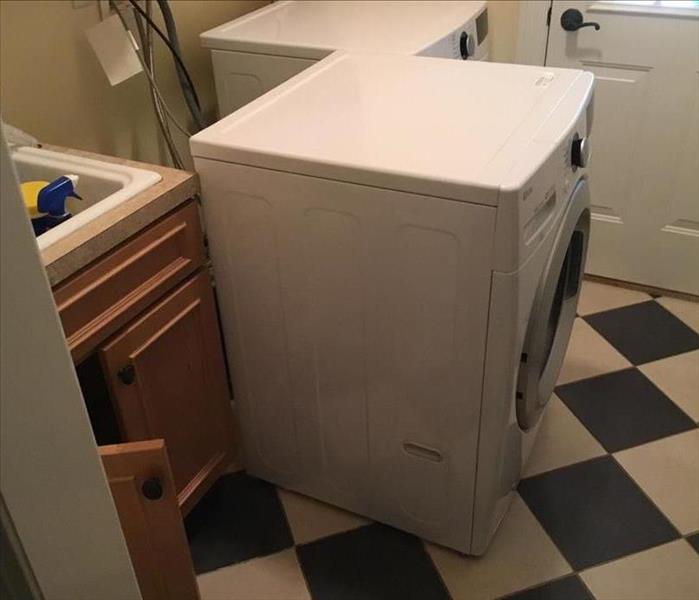 Incorrect installation of this washing machine caused a flood in a finished basement.
Incorrect installation of this washing machine caused a flood in a finished basement.
It’s easy to throw your clothes into the washing machine, set it, and forget it. Washing machines generally work so well, we can feel totally unprepared and thrown off guard if there’s a malfunction.
Unfortunately, the damage that can be caused by a broken washing machine can be severe. One load of laundry generally uses about 30 gallons of water, which is enough to fill a typical bathtub. All it takes is one broken hose or damaged seal, and you can have a huge water problem on your hands
Here at SERVPRO Hackensack / Little Ferry, we want to make sure you’re prepared to deal with a washing machine flood, so that you can minimize any long-term damage as much as possible.
Here’s your step-by-step guide for how to properly clean up after a washing machine flood:
Stop the Water at its Source and Turn Off Your Washing Machine
When your washing machine starts to malfunction, the first thing you want to do is cut off the water supply and unplug the machine.
To disconnect the water, you can either turn off the water valves to the machine, or just shut down your main water supply to stop the problem as quickly as you can.
You’ll also want to make sure your machine is fully unplugged to prevent the risk of electrical shock while you clean up the water.
Remove the Water
Next, you’ll want to remove as much water as you can.
You may need buckets, or at least a mop and towel to soak up standing water. You can also use a wet/dry vacuum to pull water up from porous materials like rugs and wood.
Dry Out the Affected Area
You want to dry out the affected area as quickly as possible.
Remove & Dry Your Clothes
Once you’ve dried the flood mess, you can turn your attention to the clothes you left in the machine.
Now is the time to remove and dry these items. You may find that there was also flooding inside the machine. If so, you’ll want to clear out any standing water and make sure the inside of your washing machine dries.
Dispose of Anything that Can’t be Salvaged
Unfortunately, some of your items may have been destroyed by the flooding.
Now is the time to dispose of items that cannot be restored
Sanitize the Affected Area
Once the affected area has been cleared out, it’s time to sanitize. A flooding problem can lead to a risk of mold growth and/or the spreading of contaminants. So, it’s important to use a disinfectant.
If you’re worried about potential mold growth, you can use a solution of one-part water to one-part bleach to sanitize the area.
Restore, Rebuild, and Replace, If Necessary
Once everything has been cleaned, it may be necessary to rebuild or restore what got damaged in the flooding.
You may need to paint the walls or install new carpeting. There may even be need to address your building structure to make sure the flood won’t have a long-term effect on the integrity and stability of your building materials.
If you need any help with clean up and/or restoration after a washing machine flood, know that SERVPRO of Hackensack/Little Ferry is here to help.
You can give us a call anytime 24/7 at: 201-441-1343.
Your Checklist to Prevent Potentially Expensive Plumbing Problems
7/29/2019 (Permalink)
How often do you think about your plumbing? It’s easy to take for granted that you can turn on a tap and water will just start flowing, no problem.
Unfortunately, many homeowners overlook issues that could develop into significant plumbing problems, and maybe even expensive water damage.
Because we know how difficult it can be to deal with a major plumbing leak, we want to make sure everybody knows about proper prevention. The good news is that an easy visual inspection or simple test is often all it takes to ensure your plumbing is in good working condition and catch any problem before it becomes as major catastrophe.
Here’s a checklist of 4 common plumbing problems, and what you can do to prevent them from becoming a problem for you:
- Washing Machine
Did you know that the average washing machine will use up to 40 gallons of water each cycle? With that much water pumping through, you want to be sure to check both the supply and wastewater lines about once a quarter.
Be on the lookout for any signs of wear-and-tear or damage – a tiny drip leak could quickly turn into a major water hassle.
- Sinks
One of the biggest wear-and-tear problems for sinks are the seals and washers which will deteriorate over time. When that happens, you may not only be dealing with wasted water but a potential mold problem too.
You’ll want to check under the sink cabinets for any signs of leaking, which could include dampness, deterioration, or odors.
- Toilet
When your toilet starts to wear down, it could lead to higher monthly water bills, or even potential flooding and major water damage.
In order to inspect your toilet, remove the tank lid and flush and make sure all the components (like the flush valve and flapper) are all in good working condition.
One easy way to check for a toilet leak is to add a couple drops of food coloring into the tank. After a few hours, check the bowl – if you see the dye color, then you know there’s a leak problem.
- Showers & Tubs
Showers and tubs are often the most heavily used plumbing fixtures in a home, so it’s important to make sure everything is working properly.
You’ll want to check all the metal components like faucets, drains, and shower heads on a regular basis. You’ll also want to check the seals. If caulk deteriorates, it could lead to a mold problem behind your walls.
If you see any signs of damage or corrosion, or if you decide you’d like a professional opinion, our team of experts here at SERVPRO Hackensack / Little Ferry can help make sure you minimize any water damage. And if you do need more advanced help, know that we have all the specialized training and equipment necessary to handle even a large-scale water emergency.
Your Guide to Drying Carpeting after Flooding and/or Water Damage
5/3/2019 (Permalink)
If your home or business has been damaged by flooding or a water leak, your carpeting may be a soggy, water-logged mess. When this happens, it’s imperative to dry the carpeting quickly in order to prevent damage to your walls, sub-flooring or any other structural elements of your building. The good news is: the drying process is one you can often start on your own until the professionals get there.
Here at SERVPRO of Hackensack/Little Ferry, we know how devastating water damage can be to a home or business. As a leader in professional restoration services here in this community, we want to help make sure you mitigate any damage that may occur to your property due to a water problem.
Here’s your step-by-step guide to start drying your wet carpeting in order to prevent further damage:
Identify and Stop the Source of the Water Problem
There’s no sense in doing the work to dry out your carpeting if will just continue to get flooded. While you’re working on figuring out the cause of your water problem, see if you can find a way to at least prevent further water damage.
Remove Any Standing and/or Excess Water
Once there’s no more water coming in, your next step is to start to remove any standing or excess water.
A useful tool is a wet/dry shop vac which can be used to suck up excess water from a saturated carpet.
Separate the Soaked Carpeting from the Floor
Once you’ve removed most of the water, now you will want to separate the carpet off from the floor.
Begin along a wall, pulling away from the tack strips and moving across the room. Be careful not to use too much force in handling your carpeting, as wet carpeting is more fragile than normal and more likely to tear.
Once you’ve pulled up the carpeting, you’ll want to dispose of the carpet padding. (Carpet padding is typically inexpensive and generally easier to just replace than to try to dry out).
Dry, Dry, Dry!
Once the carpeting is separated from the flooring, it’s time to do your best to dry both completely.
It’s often useful to move the carpeting to another totally dry area. Use high-powered fans and/or blowers on both the flooring and the carpeting. Although a household fan may work in a pinch, if you can rent a professional-grade blower, the process is typically much faster and more likely to end with a positive outcome.
It is also useful to use a dehumidifier to remove the excess humidity and speed up the drying process, however typical models are not sufficient enough on their own.
Clean the Floor and Sub-Flooring
Make sure to thoroughly sanitize the subflooring to prevent mold growth and odors. Ideally, a medical grade sanitizer is best in this kind of situation, but you can also try a solution of one-part bleach to one-part water.
Bring In Professional Restoration Services
Because SERVPRO has specialized equipment that can do a job faster and more efficiently, even if you start with extraction and dehumidification, it is in your best interest to call the professionals who will do the job completely and safely.
How to Prevent Water Damage: Everyday Tips and DIY Tricks
2/26/2019 (Permalink)
Water damage can be unpredictable. However, there are steps you can take to help prevent it. In fact, it can be quite easy to make sure your plumbing and HVAC systems are in good working order.
Here at SERVPRO of Hackensack/Little Ferry, we’re proud to be leaders in cleaning and restoration services here in this community. Our team of advanced technicians has all the specialized knowledge, training, and equipment necessary to handle any size disaster. But rather than cleanup after a disaster, we’d like to help you prevent major damage from occurring in the first place.
Here are some ways you can prevent water damage on a day-today basis, both when you’re at home and traveling away for an extended period:
Everyday Water Damage Prevention Tips
If you’re careful about what goes down your drains, you can help prevent cracks and damage to your pipes that might otherwise lead to leaks and water problems.
- Be careful what goes down your toilet. It’s a good idea to flush only human waste and toilet paper. Note: even “flushable” wipes can clog toilet drains, especially in bulk.
- Make sure not to pour grease or coffee grounds down drains as these can clog pipes and sewer lines.
- If you have a drain clog, try using a drain snake rather than a chemical cleaner as a snake is typically both more effective and less hazardous.
DIY Water Damage Preventative Maintenance
Here are some easy DIY steps you can take to inspect and maintain your water supply. If you do notice signs of wear and tear or incorrect operations, be sure to call professional services soon before a small problem turns into a major home disaster.
- Clean your gutters regularly and be sure to check them after heavy storms to make sure water is flowing properly.
- Once a year, make sure to visually inspect your plumbing - including any toilets, sinks, tubs, washing machines, or dishwashers – and look for any signs of damage or leaking.
- Flush your sinks with baking soda and vinegar to help prevent clogs. You can use lemon juice to eliminate any odors.
- Consider investing in a sump pump in case of flooding and be sure to check it regularly to make sure it is in good working order.
- Pay attention to your water bill each month. An unexpected increase may indicate that water is leaking somewhere.
Water Damage Prevention When Traveling
If you’ll be traveling away on vacation, here are steps you can take before you leave to help prevent any water problems while you’re away.
- Adjust your HVAC settings to a lower setting while your away to prevent pipes from freezing during cold weather.
- Consider turning off your water supply and draining your pipes.
- Ask a neighbor to check on your house every few days to make sure there aren’t any developing problems.
While it’s not always possible to prevent water damage, these tips can help minimize your chances of having to deal with a major water-related emergency. And if something should happen, know that SERVPRO of Hackensack/Little Ferry is available 24/7 to help deal with any size water damage problem, large or small.
Know Your Water
1/16/2019 (Permalink)
The dictionary definition of wastewater is "any water that has been affected by human use." But did you know that there are different grades of wastewater? The longer you wait to take care of your water issue, the more damage can occur - to your home, your possessions and even your health.
CLEAN WATER
Floodwater that does not pose an immediate health threat is known as clean water. Clean water floods can result from malfunctioning appliances, toilet holding tanks, and melting snow and rainwater. Clean water home floods are generally safe for you to clean up yourself, but remember--time is an important factor. Standing clean water can become greywater if left untreated.
GREYWATER
Greywater refers to wastewater that is not contaminated with fecal matter. As far as household wastewater goes, greywater could include water from bathtubs and showers, appliances such as dishwashers, a weather event, an overflowing plumbing fixture or appliance or even a broken pipe.
When flooding occurs, it can saturate carpeting, furniture and drywall. If you experience a home flood with greywater, wear protective gear, and keep children and pets away from the flooded area. If the flood is extensive, such as several inches of water in the basement, it is advisable to hire professionals to safely clean up and decontaminate the area. Cleanup must begin as soon as possible as greywater can become blackwater if left untreated.
BLACKWATER
Blackwater is wastewater contaminated with human waste, flood water, or water contaminated with chemicals.
Blackwater floods are the most dangerous and the most destructive, and must be cleaned and mitigated immediately. Because of the unsanitary conditions of the water, items such as carpets, upholstery and drywall are often unsalvageable. Contact with blackwater can cause illness in both humans and pets.
Having water damage in your home is never a pleasant experience, and oftentimes it is destructive, and disruptive - affecting multiple rooms, floors, levels – of a home, office or multiple dwelling. Knowing whom to call and when, could mean all the difference in keeping contamination and damage to a minimum.
Remember that you can call SERVPRO of Hackensack/Little Ferry 24/7. We will be there to survey and clean up your water damage quickly and get you back to your normal routine as quickly as possible.
What to Do About Ceiling Water Damage
12/11/2018 (Permalink)
It’s bad enough having to deal with freezing rain and snow outside – what’s worse is having to deal with an indoor leak that causes ceiling water damage.
Whatever the cause, it’s critical to repair ceiling water damage quickly. A water damaged ceiling could compromise the structural integrity of your home, or lead to mold growth that could impact the health of you and your family.
Here at SERVPRO of Hackensack/Little Ferry we understand how frustrating it can be when you’re dealing with ceiling water damage. Our experienced, friendly restoration professionals are available anytime to help you get your home back to normal as soon as possible. We offer:
- 24/7 Emergency Service
- “Faster to Any Size Disaster” Restoration Services
- Locally Owned & Part of a Network of Over 1700 Franchises Across the Continent
- Advanced Restoration Equipment & Highly Trained Technicians
- We can even help you work with your insurance!
To help you deal with ceiling water damage in your home, here’s a helpful step-by-step guide:
Identify the Water Source
Before you can clean-up and restore water damage to your ceiling, you first need to find and stop the source of the leak.
What if you can’t find the exact source of your leak? This is just one way that SERVPRO restoration professionals can help! Give us a call and we’ll find the source of your leak ASAP so you can get your house back to normal.
Stop the Leak
Once you’ve figured out the source of your leak, it’s time to stop the water flow and repair your ceiling. The method of stopping the leak depends on the source.
Remove Damaged Ceiling Materials
Proper drying is essential to fix ceiling water damage. If water is left to stand for extended periods of time, it can lead to mold and mildew growth that can cause further damage and potential health risks.
Restoring ceiling water damage doesn’t have to be a painful process. Calling SERVPRO insures that this will be done correctly and professionally with minimal damage to the rest of your home or business.
What to Do if Your Water Heater Leaks
12/10/2018 (Permalink)
Finding out that your hot water heater is leaking is never a pleasant experience. But this minor emergency doesn’t have to become a major disaster.
Here’s a list of steps you can take to minimize the damage from a leaking heater:
Confirm that it is, in fact, your water heater that’s leaking.
If there are puddles on the floor, check to see where they originated from.
Turn off the water.
If you do have a leaking water heater, the next recommended step is to turn off the water.
Your hot water heater should have its own shut off valve.
If your valve is broken, you may need to shut off the water to your home. If you need assistance, reach out to your local expert professionals.
Cut the power.
Whether you have a gas or electrically powered water heater, your next step is to shut off the fuel source that powers your heater.
A gas tank should have its own dedicated shut-off gas valve. You want to make sure the gas is off so your heater will be safe to work with. If you have an electric tank, you can shut off the power at the breaker.
Try to determine the location and cause of the leak.
Now that the water and power are off, you will be in a better position to assess your situation and try to determine the location and course of your leak.
- Check the pipes that connect to your heater for any loose fittings. This may just require quick tightening with a wrench.
- Check your pressure relief valve. If the temperature or pressure is too high, this could be causing valve leaks. Your water heater should be around 120 degrees Fahrenheit and the pressure shouldn’t be over 80 PSI.
- Check the drain valve to make sure it doesn’t need replacing.
- Check the bottom of the water heater itself -- it may be that the tank itself is cracked and needs to be replaced.
If you determine that it is your tank that is leaking and the leak is serious, you may want to drain the tank to minimize further water damage.
Hopefully, the leak from your hot water heater hasn’t caused too much water damage. But if you need professional assistance, the restoration pros at SERVPRO Hackensack/Little Ferry are here to help. We’re equipped to handle any size water damage restoration needed for either residential or commercial buildings.
A Simple Step-By-Step Guide for Dealing with Water Damage
10/26/2018 (Permalink)
It’s a homeowner’s nightmare: water damage. An extensive water problem in your home can feel overwhelming.
If you’re staring at a pool of water in your home and wondering what to do next, here’s a step-by-step guide to help you start getting everything back to normal:
Call for Professional Water Damage Restoration Services ASAP
The simple fact is, the quicker you bring in professional help, the better your chances of minimizing the long-term damages and costs.
SERVPRO of Hackensack / Little Ferry is a locally owned and operated organization of highly trained technicians with the expertise and advanced technological equipment needed to clean-up and repair your water damage fast. We’re ready to respond to your emergency situation immediately, and we will oversee and document the entire process until your home is fully restored.
Check Your Insurance Coverage
Once help is on the way, check your homeowner’s insurance to see if your water damage will be covered.
You’ll want to act fast in order to make a claim. It’s also a good idea to take photos to document the evidence.
Remove Any Items You Can
When you’re dealing with water damage, don’t forget: safety first.
If it is safe to do so, remove any items you can from the affected area. It’s a good idea to gather any loose items from the floor, especially colored rugs, or other colored materials that might leave a stain. Prioritize the removal of any valuables as well as any wet items like cushions or upholstery that can be taken out to dry.
Dry Out the Damaged Area
If it is safe, start drying out the wet area.
Mops and buckets can be useful to remove excess water quickly. Also wipe down any wood or porous objects that may be more sensitive to water damage. Open windows and doors to allow maximum air circulation.
While a wet-dry vac can be a useful tool to deal with minor flooding, NEVER use a vacuum cleaner to remove excess water.
If you have a water damage emergency, the professionals of SERVPRO Hackensack / Little Ferry are available to help 24/7.
As part of the service, SERVPRO of Hackensack / Little Ferry will also help you manage the insurance paperwork process.
Bergen County area residents: We Specialize in Flooded Basement Cleanup and Restoration!
1/18/2017 (Permalink)
A basement can flood at any time, although flooding most often occurs during heavy rainfall. Basements are inherently prone to flooding because they are the lowest level of a building and are normally built partly or entirely below ground level. There are a number of reasons why your basement could flood, including:
- A blocked or failed sewer lateral pipe
- Heavy rain causes surface water to pool around your home
- Storm sewer backup
- Sanitary sewer backup
- Foundation drainage failure
- Water supply-line break or hot-water tank failure
- And many more





 24/7 Emergency Service
24/7 Emergency Service




















